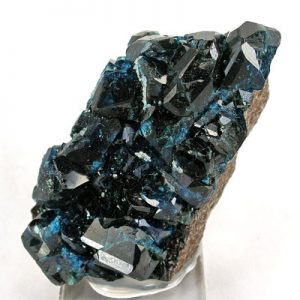Lazulite
Lazulite ((Mg, Fe2+)Al2(PO4)2(OH)2) is a blue, phosphate mineral magnesium this is certainly containing iron and aluminium phosphate. Lazulite forms one endmember of a solution that is good with the darker iron scorzalite this is certainly rich. Lazulite crystallizes in the monoclinic system. Crystal habits include high bipyramidal or crystals that are wedge-shaped. Lazulite has a Mohs hardness of 5.5 to 6 and a gravity this is certainly specific to 3.1. It is actually infusible and insoluble Lazulite is a rare treasure because the material that is most is opaque and suitable only for cabochons. The transparent product that is rough for faceted gems is very rare and crystals can be small and usually greatly included. Lazulite gems from Brazil are small, but a breathtaking blue that is vivid gems from Pakistan are larger and may even be described as a deep bluish green. Both make for beautiful gems.
Lazulite is too soft for precious jewelry but adds color that is nice any gem collection. It forms by high-grade metamorphism of high silica quartz-rich rocks and in pegmatites. It occurs in association with quartz, andalusite, rutile, kyanite, corundum, muscovite, pyrophyllite, dumortierite, wagnerite, svanbergite and berlinite in metamorphic terrains; and with albite, quartz, muscovite, tourmaline, and beryl in pegmatites. It may be confused with lazurite, lapis lazuli or azurite. It is found in Salzburg, Austria; Zermatt, Switzerland; Minas Gerais, Brazil; Lincoln County, Georgia; Inyo County, California; the Yukon in Canada, and elsewhere. It was first described in 1795 for deposits in Styria, Austria. Its name comes from the German lazurstein, for blue stone or from the Arabic for heaven.
| Category: | Phosphate mineral |
| Formula: | (Mg,Fe2+)Al2(PO4)2(OH)2 |
| Crystallography: | Monoclinic – Prismatic |
| Crystal Habit: | As crystals, stubby to acute dipyramidal, to 15 cm, or tabular, with several other forms noted; granular, massive. |
| Cleavage: | [110] Poor to Good; [101] Indistinct |
| Fracture: | Uneven to Splintery |
| Tenacity: | Brittle |
| Moh’s Hardness: | 5.0 – 6.0 |
| Density: | 3.122 – 3.240 (g/cm3) |
| Radioactivity: | Not Radioactive |
| Color: | Azure-blue, sky-blue, bluish white, yellow-green, blue-green, rarely green |
| Transparency: | Transparent to Translucent, Opaque |
| Luster: | Vitreous |
| Refractive Index: | 1.604 – 1.677 Biaxial ( – ) |
| Birefringence: | 0.038 – 0.040 |
| Dispersion: | Weak |
| Pleochroism: | Strong; X = colorless; Y = blue; Z = darker blue |


